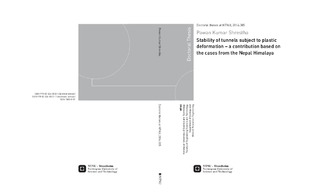| dc.contributor.advisor | Panthi, Krishna Kanta | nb_NO |
| dc.contributor.author | Shrestha, Pawan Kumar | nb_NO |
| dc.date.accessioned | 2014-12-19T11:57:10Z | |
| dc.date.available | 2014-12-19T11:57:10Z | |
| dc.date.created | 2014-12-10 | nb_NO |
| dc.date.issued | 2014 | nb_NO |
| dc.identifier | 770218 | nb_NO |
| dc.identifier.isbn | 978-82-326-0522-4 (print) | nb_NO |
| dc.identifier.isbn | 978-82-326-0523-1 (electronic) | nb_NO |
| dc.identifier.uri | http://hdl.handle.net/11250/236366 | |
| dc.description.abstract | The purpose of excavating a tunnel is not fulfilled unless it is stable. One of the major causes of instability in tunnels is induced stresses around it. Tunnels excavated in weak and schistose rock mass below high overburden (rock cover) are prone to instability in the form of tunnel deformation. The deformation in the tunnel takes place to such an extent that it is irreversible and of significant magnitude, which is often known as tunnel squeezing. In order to limit such plastic deformation in tunnels, it is desirable that the response of the rock mass to the induced stresses is known so that requirement of rock support can be estimated. Rock support interaction is an important tool in such endeavor; and the Convergence Confinement Method is the common approach used for this purpose.
Contrary to the assumption of uniform in-situ stresses made in analytical solutions for elasto-plastic analyses, large degree of stress anisotropy condition prevails in most tunnelling conditions. The effect of such anisotropic stress condition leads to varying degrees of deformations around the tunnel contour. Therefore, stress anisotropy is also an important factor that needs to be addressed to ensure a proper support design for tunnels.
This thesis assesses the inter-relationship among rock mass property, in-situ stresses including horizontal to vertical stress ratio, tunnel support pressure and deformation. The work is based on the tunnel cases from the Nepal Himalaya. For this purpose, four completed tunnel projects from that region were selected, where moderate to large tunnel deformations had been recorded. Long term deformation records were analyzed to assess time independent and time dependent deformations. Furthermore, the behavior of average quality rock mass was also evaluated using the records of multiple point borehole extensometer monitored at four tunnel sections. Evaluations were made addressing both the rock mas around the tunnel wall and at depth. In addition, the effect of groundwater on tunnel stability in faulted rock mass was also assessed in a severely squeezed tunnel.
Results of the analyses of the tunnels in weak and schistose rock mass at stress anisotropy states show that a good correlation among tunnel strain, rock mass shear modulus, support pressure, vertical stress and stress ratio of horizontal to vertical stresses exists. Moreover, the study also shows that significant amount of time dependent deformation can occur in such weak rock mass. Such deformation was found to be high in schist and micaceous phyllite, moderate in graphitic phyllite and low in siliceous phyllite. Similarly, analyses incorporating instrumentation data in average quality rocks show that stress anisotropy cause tensional cracks in tunnel crown and inverts whereas tunnel walls will have compressional failures. Moreover, the study also shows that deformation patterns in tunnels are altered by in-homogeneity in the rock mass. The study on the effect of groundwater in tunnel stability in faulted rock mass shows that groundwater can increase the tunnel strain on average 15% depending on distance from tunnel face and location in the tunnel.
This study suggests relationships that can be used as a basis for an early estimate of instantaneous and final deformations and the corresponding requirement of support pressures in tunnel walls in weak and schistose rock mass. The suggested relationships, however, are for the tunnels in plane strain conditions where face effect is not incorporated. Moreover, the relationships are based on a limited number of tunnel cases. Therefore, further validation is needed using other tunnel cases subjected to plastic deformation. | nb_NO |
| dc.language | eng | nb_NO |
| dc.publisher | Norges teknisk-naturvitenskapelige universitet, Fakultet for ingeniørvitenskap og teknologi, Institutt for geologi og bergteknikk | nb_NO |
| dc.relation.ispartofseries | Doktoravhandlinger ved NTNU, 1503-8181; 2014:305 | nb_NO |
| dc.relation.haspart | Paper 1: Shrestha, Pawan Kumar; Panthi, Krishna Kanta.
Analysis of the plastic deformation behavior of schist and schistose mica gneiss at Khimti headrace tunnel, Nepal. Bulletin of Engineering Geology and the Environment 2014 ;Volum 73.(3) s. 759-773
Is not included due to copyright.
available at <a href="http://dx.doi.org/10.1007/s10064-013-0533-0" target="_blank"> http://dx.doi.org/10.1007/s10064-013-0533-0</a | |
| dc.relation.haspart | Paper 2: Shrestha, Pawan Kumar, Panthi, Krishna Kanta; Assessment of the effect of stress anisotropy on tunnel deformation in the Kaligandaki project in the Nepal Himalaya.
Published online 15 July 2014 in Bulletin of Engineering Geology and the Environment
Is not included due to copyright.
available at <a href="http://dx.doi.org/10.1007/s10064-014-0641-5 " target="_blank"> http://dx.doi.org/10.1007/s10064-014-0641-5 </a | |
| dc.relation.haspart | Paper 3: Shrestha, Pawan Kumar, Panthi, Krishna Kanta ; Predicting plastic deformation in tunnels – an analysis based on tunnel cases from the Nepal Himalaya. | |
| dc.relation.haspart | Paper 4: Shrestha, Pawan Kumar, Panthi, Krishna Kanta:
Interpretation of deformation characteristics at Kaligandaki Headrace Tunnel using tunnel monitoring record | |
| dc.relation.haspart | Paper 5:
Shrestha, Pawan Kumar; Panthi, Krishna Kanta.
Groundwater Effect on Faulted Rock Mass: An Evaluation of Modi Khola Pressure Tunnel in the Nepal Himalaya. Rock Mechanics and Rock Engineering 2014 ;Volum 47. s. 1021-1035
is not included due to copyright available at <a href="http://dx.doi.org/ 10.1007/s00603-013-0467-7" target="_blank"> http://dx.doi.org/ 10.1007/s00603-013-0467-7</a> | |
| dc.title | Stability of tunnels subject to plastic deformation – a contribution based on the cases from the Nepal Himalaya | nb_NO |
| dc.type | Doctoral thesis | nb_NO |
| dc.contributor.department | Norges teknisk-naturvitenskapelige universitet, Fakultet for ingeniørvitenskap og teknologi, Institutt for geologi og bergteknikk | nb_NO |
| dc.description.degree | PhD i geologi og bergteknikk | nb_NO |
| dc.description.degree | PhD in Geology and Mineral Resources Engineering | en_GB |

